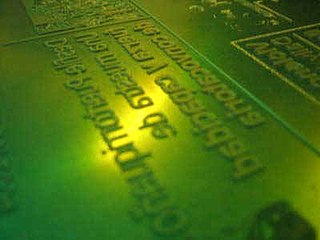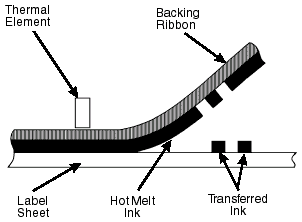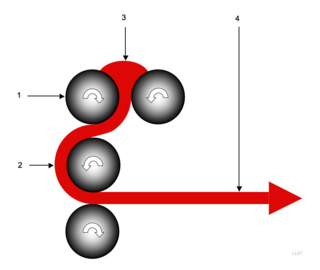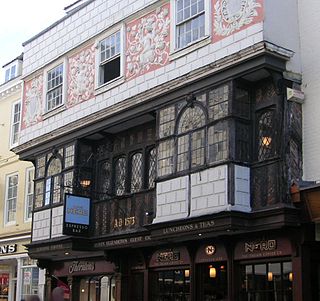This article needs additional citations for verification .(June 2019) |

A laminator is a device which laminates pieces or rolls of paper or card stock.
This article needs additional citations for verification .(June 2019) |

A laminator is a device which laminates pieces or rolls of paper or card stock.
A pouch laminator uses a plastic pouch that is usually sealed on one edge. The inside of the lamination pouch is coated with a heat-activated film that adheres to the product being laminated as it runs through the laminator. The substrate side of the board contains a heat-activated adhesive that bonds the print to the substrate. This can be any of a number of board products or another sheet of laminate. The pouch containing the print, laminate, and substrate is passed through a set of heated rollers under pressure, ensuring that all adhesive layers bond to one another.
Pouch laminators are designed for moderate use in the office or home. For continuous, large-volume lamination projects, a roll laminator performs more efficiently.
Pouches can be bought with different thicknesses in micrometres. Standard home or office machines normally use 80–250 micrometre pouches, depending on the quality of the machine. The thicker the pouch, the higher the cost. Pouches can also measured in mil, which equals one thousandth of an inch. The most common pouch thicknesses are 3, 5, 7 and 10 mil (76, 127, 178 and 254 μm).
Certain pouches such as butterfly pouches can be used with a pouch laminator to form ID cards. Butterfly pouches are available with magnetic stripes embedded.
Many pouch laminators require the use of a carrier. A carrier holds the pouch as it is run through the laminator. This helps prevent the hot glue, some of which leaks from the sides of the pouches during the process, from gumming up the rollers. The carrier prevents the rollers from getting sticky, which helps to prevent the lamination pouch from wrapping around the rollers inside the laminator.
Many newer laminators claim that they can be used without a carrier. However the use of carriers will extend the laminator's life. [1]
A heated roll laminator uses heated rollers to melt glue extruded onto lamination film. This film is in turn applied to a substrate such as paper or card using pressure rollers. The primary purpose of laminating with such a machine is to embellish or protect printed documents or images. Heated roll laminators can vary in size from handheld or desktop pouch laminators to industrial sized machines. Such industrial laminators are primarily used for high quantity/quality output by printers or print finishers.
Such laminators are used to apply varying thicknesses of lamination film onto substrates such as paper or fabrics. The main advantage of the use of heated roll laminators is speed. Heated laminators use heated rollers or heated shoes to melt the glue which is applied to lamination film. The process of heating the glue prior to applying the film to a substrate allows for a faster application of the film. The laminates and adhesives used are generally cheaper to manufacture than cold roll laminates, often as much as half the cost depending on the comparison made. As the materials are non-adhesive until exposed to heat, they are much easier to handle. The glue is solid at room temperature, so lamination of this type is less likely to shift or warp after its application than pressure activated laminates, which rely on a highly viscous, adhesive fluid.
Roll laminators typically use two rolls to complete the lamination process, with one roll being on top and the other roll on the bottom. These rolls slide onto metal bars, known as mandrels, which are then placed in the machine and feed through it. In the United States, the most common core size found on lamination film is one inch (25- to 27-inch-wide film). Larger format laminators use a larger core, often 21⁄4 to 3 inches in diameter. Film is usually available in 1.5, 3, 5, 7, and 10 mil thicknesses. The higher the number, the thicker the film. A mil is one thousandth of an inch (.001"). [2]
Printers or print finishers often use industrial heated roll laminators to laminate such things as paperback book covers, magazine covers, posters, cards and postcards, in-shop displays as well as other applications.
Cold roll laminators use a plastic film which is coated with an adhesive and glossy backing which does not adhere to the glue. When the glossy backing is removed, the adhesive is exposed, which then sticks directly onto the item which needs to be laminated. This method, apart from having the obvious benefit of not requiring expensive equipment, is also suitable for those items which would be damaged by heat. Cold laminators range from simple two roller, hand-crank machines up to large and complex motor-driven machines with high precision rollers, adjustable roller pressure, and other advanced features.
Cold lamination increased in popularity with the rise of wide-format inkjet printers, which often used inks and papers incompatible with hot lamination. A large percentage of cold laminate for use in the print industry is PVC, although a wide range of other materials are available. Cold laminating processes are also used outside of the print industry, for example, coating sheet glass or stainless steel with protective films.
Cold roll laminators are also used for laying down adhesive films in the sign-making industry, for example mounting a large print onto a board. A practiced operator can apply a large adhesive sheet in a fraction of the time it takes to do so by hand.

Adhesive, also known as glue, cement, mucilage, or paste, is any non-metallic substance applied to one or both surfaces of two separate items that binds them together and resists their separation.

Flexography is a form of printing process which utilizes a flexible relief plate. It is essentially a modern version of letterpress, evolved with high speed rotary functionality, which can be used for printing on almost any type of substrate, including plastic, metallic films, cellophane, and paper. It is widely used for printing on the non-porous substrates required for various types of food packaging.

BoPET is a polyester film made from stretched polyethylene terephthalate (PET) and is used for its high tensile strength, chemical and dimensional stability, transparency, reflectivity, gas and aroma barrier properties, and electrical insulation. A variety of companies manufacture boPET and other polyester films under different brand names. In the UK and US, the best-known trade names are Mylar, Melinex, Lumirror and Hostaphan.

Flexible electronics, also known as flex circuits, is a technology for assembling electronic circuits by mounting electronic devices on flexible plastic substrates, such as polyimide, PEEK or transparent conductive polyester film. Additionally, flex circuits can be screen printed silver circuits on polyester. Flexible electronic assemblies may be manufactured using identical components used for rigid printed circuit boards, allowing the board to conform to a desired shape, or to flex during its use.

Thermal-transfer printing is a digital printing method in which material is applied to paper by melting a coating of ribbon so that it stays glued to the material on which the print is applied. It contrasts with direct thermal printing, where no ribbon is present in the process.

Lamination is the technique/process of manufacturing a material in multiple layers, so that the composite material achieves improved strength, stability, sound insulation, appearance, or other properties from the use of the differing materials, such as plastic. A laminate is a permanently assembled object created using heat, pressure, welding, or adhesives. Various coating machines, machine presses and calendering equipment are used.

Thermal printing is a digital printing process which produces a printed image by passing paper with a thermochromic coating, commonly known as thermal paper, over a print head consisting of tiny electrically heated elements. The coating turns black in the areas where it is heated, producing an image.

Rotogravure is a type of intaglio printing process, which involves engraving the image onto an image carrier. In gravure printing, the image is engraved onto a cylinder because, like offset printing and flexography, it uses a rotary printing press.

A calender is a series of hard pressure rollers used to finish or smooth a sheet of material such as paper, textiles, rubber, or plastics. Calender rolls are also used to form some types of plastic films and to apply coatings. Some calender rolls are heated or cooled as needed. Calenders are sometimes misspelled calendars.
A platen is a flat platform with a variety of roles in printing or manufacturing. It can be a flat metal plate pressed against a medium to cause an impression in letterpress printing. Platen may also refer to a typewriter roller which friction-feeds paper into position below the typebars or print head. It can refer to the glass surface of a copier, and the rotating disk used to polish semiconductor wafers.

In metalworking, rolling is a metal forming process in which metal stock is passed through one or more pairs of rolls to reduce the thickness, to make the thickness uniform, and/or to impart a desired mechanical property. The concept is similar to the rolling of dough. Rolling is classified according to the temperature of the metal rolled. If the temperature of the metal is above its recrystallization temperature, then the process is known as hot rolling. If the temperature of the metal is below its recrystallization temperature, the process is known as cold rolling. In terms of usage, hot rolling processes more tonnage than any other manufacturing process, and cold rolling processes the most tonnage out of all cold working processes. Roll stands holding pairs of rolls are grouped together into rolling mills that can quickly process metal, typically steel, into products such as structural steel, bar stock, and rails. Most steel mills have rolling mill divisions that convert the semi-finished casting products into finished products.

A countertop, also counter top, counter, benchtop, worktop or kitchen bench, bunker is a raised, firm, flat, and horizontal surface. They are built for work in kitchens or other food preparation areas, bathrooms or lavatories, and workrooms in general. The surface is frequently installed upon and supported by cabinets, positioned at an ergonomic height for the user and the particular task for which it is designed. A countertop may be constructed of various materials with different attributes of functionality, durability and aesthetics, and may have built-in appliances, or accessory items relative to the intended application.

Architectural glass is glass that is used as a building material. It is most typically used as transparent glazing material in the building envelope, including windows in the external walls. Glass is also used for internal partitions and as an architectural feature. When used in buildings, glass is often of a safety type, which include reinforced, toughened and laminated glasses.

Laminated object manufacturing (LOM) is a rapid prototyping system developed by Helisys Inc. In it, layers of adhesive-coated paper, plastic, or metal laminates are successively glued together and cut to shape with a knife or laser cutter. Objects printed with this technique may be additionally modified by machining or drilling after printing. Typical layer resolution for this process is defined by the material feedstock and usually ranges in thickness from one to a few sheets of copy paper.
In-mould labelling is the use of paper or plastic labels during the manufacturing of containers by blow molding, injection molding, or thermoforming processes. The label serves as the integral part of the final product, which is then delivered as pre-decorated item. Combining the decoration process with the moulding process cuts the total cost, but can increase the manufacturing time. The technology was first developed by Owens-Illinois in cooperation with Procter & Gamble to supply pre-labelled bottles that could be filled on the product filling line. This was first applied to Head & Shoulders shampoo bottles.

Pressure-sensitive adhesive is a type of nonreactive adhesive which forms a bond when pressure is applied to bond the adhesive with a surface. No solvent, water, or heat is needed to activate the adhesive. It is used in pressure-sensitive tapes, labels, glue dots, stickers, sticky note pads, automobile trim, and a wide variety of other products.

Sheet metal embossing is a stamping process for producing raised or sunken designs or relief in sheet metal. This process can be made by means of matched male and female roller dies, or by passing sheet or a strip of metal between rolls of the desired pattern. It is often combined with foil stamping to create a shiny, 3D effect.

Roll slitting is a shearing operation that cuts a large roll of material into narrower rolls. There are two types of slitting: log slitting and rewind slitting. In log slitting the roll of material is treated as a whole and one or more slices are taken from it without an unrolling/re-reeling process. In rewind slitting the web is unwound and run through the machine, passing through knives or lasers, before being rewound on one or more shafts to form narrower rolls. The multiple narrower strips of material may be known as mults or pancakes if their diameter is much more than their width. For rewind slitting the machine used is called a slitter rewinder, a slitter or a slitting machine – these names are used interchangeably for the same machines. For particularly narrow and thin products, the pancakes become unstable, and then the rewind may be onto a bobbin-wound reel: the rewind bobbins are much wider than the slit width and the web oscillates across the reel as it is rewound. Apart from the stability benefit it is also then possible to put very long lengths,, onto one bobbin.
Heat transfer vinyl, or HTV for short, is a speciality polyurethane with a heat-activated adhesive that can be used on certain fabrics and materials to apply designs to promotional products, textiles and apparel, such as T-shirts. It comes laminated together with a clear polyester carrier in a roll or sheet form, with an adhesive tacky backing, so it can be cut, weeded, and placed on a substrate for application via a heat press. The design is cut into the material with a cutting plotter in reverse. The excess material is removed with tools such as hooks or tweezers - a manual and dextrous process referred to as "weeding". The tacky adhesive between the carrier and the vinyl holds together complex designs, although the labour naturally increases the more weeding that is required. The clear polyester carrier keeps the design visible to aid positioning on the substrate. For these and other reasons, it is a popular and more robust alternative to transfer paper. Heat transfer vinyl is made in single colors and also has special options such as patterned, glitter, flocked, holographic, glow-in-the-dark, reflective and 3D puff. Heat transfer vinyl also benefits from a high degree of stretch and rebound, achieved by a memory effect, making it suitable for use on apparel and other flexible items including the garments typically used, such as sports jerseys.

A vehicle vinyl wrap is the automotive aftermarket practice of completely or partially covering a vehicle's original paint with a vinyl wrap. Generally this vinyl wrap will be a different color or finish like a gloss, matte or clear protective layer.